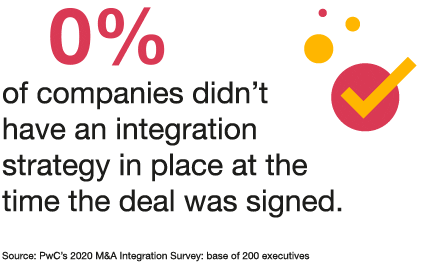{{item.title}}
{{item.text}}

{{item.text}}
The terms are settled, the contract is signed and the transaction has closed. But your deal is far from done. After putting in the hard work to acquire another company, are you ready to integrate it with your own?
Acquirers often overlook integration in the early stages of M&A, but successful integration can help drive transformation. If you want the deal to create the anticipated value for your company, early planning for transformation is essential.
That includes developing a strategy for retaining the strongest talent — at both the acquired company and your own — and building on the culture that this talent reflects. It’s not easy. In our 2020 M&A Integration Survey, only 10% of the respondents reported “significant success” in post-M&A employee retention. Now consider that 65% said access to talent was either “very important” or the “most important” goal of an acquisition. Here are five things you should do to get this and other critical parts of M&A integration right.


The odds of deal success improve when an acquirer is proactive with its integration strategy, and having a concrete plan well before closing is crucial. Craft your integration strategy while drafting the deal thesis — making it a part of the acquisition strategy — to increase the chance of success.
Outlining every phase of integration with guidelines for each department and team is an important step for protecting value. You’ll want to consider the degree of integration in each business area — whether they’ll partially integrate (and how much), fully integrate or remain separated. And your playbook should include a process for identifying the employees who have the knowledge and skills necessary to complete the integration.
Successful integration requires assigning staff to the effort full-time, and not just in obvious places. Our integration survey found that a healthy majority of deals have involved dedicated operations and HR personnel. On the flip side, full-time participation by IT and sales and marketing teams occurred in less than half of deals. Those areas also can be critical for integration success.
Only half of our survey respondents said they had a communications strategy in place at deal signing. Acquisitions and integrations already raise plenty of questions, and when leaders aren’t in sync on messaging, uncertainty and confusion among employees can grow. In addition to enterprise-wide communication, consider communicating function by function and area by area. This way everyone can get consistent information on a regular basis.
Only 4% of companies in our integration survey said their change management programs include incentives. That’s a huge missed opportunity. While monetary incentives like retention bonuses are obvious, think about what else employees want. That can include benefits and programs that make their work easier, allow them to develop and progress, contribute to a healthy workplace culture and demonstrate your company’s purpose. By setting up processes well in advance of integration to gather employee feedback and preserve what’s valuable to employees, you’ll increase the chances that critical talent will stick around.
{{item.text}}

{{item.text}}
